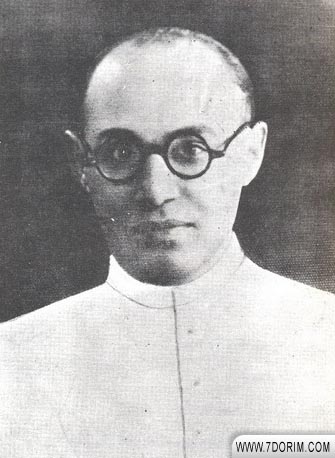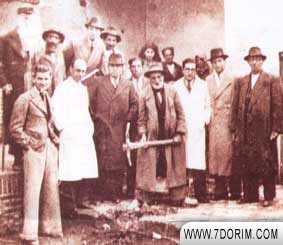
Dear Dr. Ruhollah Sapir:
The founder of health, cultural and social institutions of Iranian Jews 1322-1290
Kanoon-e Kheyrkhah Charity Center
Inaugerated in 1942 at the Molla Hanina Synagogue, Kanoon-e Kheyrkhah Charity Center was a small initiative that steadily grew, propelled by Divine assistance, the noble intentions of its founders, and the Jewish community, along with occasional support from Jews abroad. From its inception, the center offered health and medical facilities to all citizens, irrespective of race, religion, or ethnicity.
It was in the 1940s when the Iranian Jewish Youth Center, led by Benjamin Nahorai, convened with member Dr. Rahim Cohen, who had witnessed the plight of Jewish patients and their mistreatment in hospitals. He proposed expanding the center’s programs to include health care and aid for wandering and marginalized Jewish patients. The proposal received unanimous approval.
Dr. Cohen invited Dr. Sapir to join and collaborate with the initiative. Dr. Sapir accepted enthusiastically. At the first meeting with Dr. Sapir in attendance, he was appointed as the president of the center. Their initial steps involved educating the less fortunate on hygiene. Subsequently, they embarked on establishing a base.
Several sites were suggested, but they eventually chose the Molla Hanina Synagogue. With the cooperation of Yosef Melamed (the synagogue’s administrator), the Charity Center, led by Dr. Ruhullah Sapir, laid the foundation of the first medical center. They officially commenced operations with minimal furnishings—just a few chairs, a table, and a simple bench.

The dedication ceremony of Kanon Kheirkhah Clinic (November 1321)
Professor Aziz Bana, Dr. Nasser Akhtarzad, Dr. Rahim Kohan, Daei Yaqub Masaband, Abdullah Yom Toub, Haj Shaban Shams, Dr. Ruhollah Sapir, Engineer Benjamin Nehuraei.
With financial assistance, however, further plans were made to construct four rooms on the ground floor of the Molla Hanina Synagogue courtyard and a meeting hall on the second floor.
As the number of patients and visitors increased, challenges arose due to shortages in medication, medical equipment, and limited admission facilities. In 1942, with support from the community and philanthropists, the Jewish Youth Center managed to make an important contribution — without pursuing personal profits, they embarked on constructing the Charity Center Clinic, a building overlooking Cyrus Street, thus marking a significant historical effort in the face of challenging circumstances.
The selfless and admirable services of the founders will always be fondly remembered. The names of these remarkable women and men, who established this charity institution with limited resources, are well-preserved in the history of Iran’s Jewish community.
However, the impacts of World War II reached Iran, bringing death, famine, unrest, and disease, particularly typhus and typhoid. These afflictions struck every home, especially the Oudlajan (Sarpolak) neighborhood in Tehran, where the large Jewish families, confined to narrow and dimly lit alleys, lacking basic hygiene, bore the brunt of contagious diseases.
Dr. Sapir’s efforts during the early years of the Charity Center Clinic’s establishment at the Molla Hanina Synagogue focused on combatting the typhus epidemic. This was a heroic beginning.
He fearlessly battled the spread of typhus in the community, dedicating himself to saving the lives of the impoverished in southern Tehran, particularly in the Oudlajan neighborhood. Despite contracting typhoid, he remained in service until his final moments. Unfortunately, due to severe exhaustion, he succumbed to death, surrendering his soul to the Creator. His sole testament before passing: Ensure the charity clinic endures.
Dr. Sapir, through the sacrifice of his life, laid the foundation for this charitable institution. Today, it stands as a source of pride and historical significance for Jews in Iran and worldwide.
The inaugural board of directors in 1941 included Engineer Benjamin Nahorai, Dr. Rahim Cohen, Engineer Rabi’ Eli, Mehdi Mahboubian, Dr. Naser Akhtarzad, Khanbaba Zahabian, Yedidia Rabbani, Yosef Haghani, Ezatollah Salimi, Nematollah Shahrara, Nematollah Gabbai, Ibrahim Mizrahi, and Dr. Ruhollah Sapir (Chairman of the Board of Directors).
After the establishment of the Islamic Republic in 1979, the Charity Center’s board ushered in a new era, renaming Cyrus the Great Hospital to Dr. Sapir. With unwavering efforts, the hospital evolved into one of Iran’s best charity healthcare institutions, viewing each day as a mission to enhance visitor services.
In 1983, responding to the hospital’s increased visitor volume, the board initiated the construction of a new clinic location. The building, featuring 30 rooms for doctors’ offices and clinics, was completed, along with the acquisition of a 400 meter house dedicated to emergency services and some hospital facilities.
By 1985, a new building in the north side of the hospital accommodated clinics, and an independent women’s ward was established. Additionally, a technical warehouse for the hospital was built on the west wing, while a new property next to the east of the hospital was purchased, housing facilities such as laundry, tailoring, central oxygen, cold room, and an electrical power plant. The upper floor was also prepared in case of need.
During the eight-year Iran-Iraq war, the hospital’s facilities were made available to support the wounded, a humble contribution that underscored the Jewish community’s commitment to their compatriots, a gesture appreciated by the officials of the Islamic Republic of Iran.
In 1991, recognizing the wear and tear over time, extensive renovations were carried out on the hospital, including medical equipment, operating rooms, and paraclinical services.
In 2001, the Sapir Hospital board decided to equip the hospital with ICU and CCU departments, achieving this in 2004 with the support of the Tehran Jewish Association and philanthropists. The cardiac department commenced operations, thanks to the employment of experienced specialists and the invaluable contributions of the late Dr. Yosef Javaheri.
In 2005, aligning with the hospital’s renovation efforts, the completion and operation of a wastewater treatment plant further underscored the commitment to modernization and quality service.
Currently, Dr. Sapir Hospital spans 3,900 square meters, featuring 102 beds with a minimum occupancy of 50%, surpassing the national average of 35%. The hospital’s overall condition is deemed acceptable in every aspect.
Patients have access to various clinical departments, covering specialties like obstetrics and gynecology, cardiology, internal medicine, general surgery, urology, otolaryngology, neurosurgery, orthopedics, pediatrics, psychiatry, and audiometry. Hospitalization and treatment take place in departments such as the emergency room, CCU, ICU, obstetrics and gynecology, pediatrics, and both general and specialized surgery.
The hospital’s social service department actively collaborates with numerous charity organizations, local services, mosques, the Jewish Elder’s Home, and other community organizations. It extends its services to all needy visitors following careful evaluation and identification.
To support the staff, the hospital’s daycare center is open, catering to the children of employees.
In addition to the clinical departments, Dr. Sapir Hospital houses active paraclinical units, including laboratory, radiology, physiotherapy, pharmacy, general and kosher kitchen, laundry, tailoring, CSR, prayer room, and a consumer cooperative.
In alignment with the Torah’s commandments, particularly “Love your neighbor as yourself”, Dr. Sapir Hospital is renowned for its charitable services not only to the Jewish community but also to non-Jewish compatriots. It stands as a well-known institution, symbolizing Iranian civilization, culture, and the noble values of Judaism on a global scale.

Dr. Sapir Hospital’s main entrance overlooking Siros Street
(Mustafa Khomeini)

The exterior of the Sapir Hospital building overlooking the former Siros Street (Mustafa Khomeini) with an area of 3900 square meters
Spring 2009

The waiting room of the charity center
1966

Teaching health issues to mothers at the charity center
Amidst World War II, contagious diseases spread in Iran, posing significant threats to the Jews of the Oudlajan neighborhood. They faced heightened risks due to the spread of typhus and typhoid, the absence of clothing disinfection centers, and the destruction of the Sarchal bathouse and Ishagh (Isaac) Shirazi bathouse. People endured severe difficulties concerning hygiene and public health. Requests for assistance from the Typhoid Control Association remained unanswered.
Moreover, Jews were denied access to Muslim baths, and there was no budget to construct a bathhouse for the Jewish community. During a meeting with the then Minister of Health, Dr. Marzban, Dr. Rahim Cohen convinced the minister to issue an order giving permission to Jews to use the Sangelaj women’s and men’s public bathhouse on Wednesdays. A year later, Solomon Senneh constructed the first modern bathhouse for Jews on Cyrus Street.
This historical account is drawn from the notes of Jahangir Banayan.

Distribution of free milk to families at the charity center
1343

Distribution of free milk to families at the charity center
1343

Patients waiting for an appointment at the charity center
1964

Baharian graduation certificate awarding ceremony
From the left: Mrs. Malheh Kashfi (sister of Dr. Sapir) – foreign guest Mr. Feder – Dr. Forozan – Ebn Musa and Madam Krupakh
1962

The ceremony of awarding the graduation certificate of Behiran at the place of the benevolent center
1343

The celebration of the graduates of Behyaran Khairkhah Institute affiliated to the Organization of Jewish Women of Iran in 1343-44

Examination of minors by the nurses of Kanun Khair Khah Hospital
1964

Training classes for nurses and mothers at the hospital of the late Mr. Dr. Matlob, a pediatrician and Mrs. Kohan, an environmental health specialist

Health services and visits to patients by patients in the homes of people covered by the hospital 1345-48

The visit of the nurse of the charity center from a house in the west side of the neighborhood in 1343

Patients at appointment time
The second floor of the women’s section
1341

The expansion of the old building of Khair khah Center
1343

The visit of Mrs. Anna Eleanor Roosevelt, the wife of the late American President, along with the American Ambassador to Iran and several personalities of the American Joint 1959

Memorial Book signed by Mrs. Anna Eleanor Roosevelt

Opening of the new department of gynecology and surgery by Farah Pahlavi in 1348

From right to left: Mr. Taban – Mr. Forozan – Dr. Per Kohana (res. of the hospital) – Yedid Siyon – Mrs. Dr. Beral – Mr. Zahabian 1348

Rabbi Uriel’s speech at the opening of a part of Dr. Sapir Hospital
June 1374

Hospital visit
On the left side of Daoud Al-Ghaniyan – Dr. Par Kohana – Unknown

The head and senior personnel of the charity center
1343-1345

The Board of Directors of Sapir Hospital at the Nurse’s Day ceremony

The Board of Directors of Dr. Sapir Hospital along with a group of employees and doctors 1373

The ceremony of the 50th anniversary of the death of Dr. Sapir in the Cyrus Synagogue
1372

The presence of community figures at the 50th anniversary ceremony of Dr. Sapir’s death in the kooroosh Synagogue in 1372

Visit of Hojjatul Eslam Mehdi Karroubi (Speaker of Parliament) to Dr. Sepir Hospital in 1372

The visit of the mayor of Region 12 to Dr. Sapir Hospital:
The head of the hospital, Dr. Moreh Sedeq and several members of the board of directors – Mr. Eskander Mikayel, Mr. Haroun Yeshayai – and Mrs. Ferengis Hasidim
1385

The visit of the mayor of the 12th district to the ICU department, along with Dr. Moreh Sedeq
1385

Ms. Hasidim is in charge of the hospital’s financial and administrative affairs

Dr. Eliyasi, a member of the Board of Directors, with more than thirty years of service at Dr. Sapir Hospital

Mr. Dr. Mohber, a surgeon at Sapir Hospital

Guard and entrance door to Sapir Hospital
Spring 2009

North side of the hospital, emergency department
Spring 2009

Parging area of the hospital, entrance to the maternity ward
Spring 2009

Emergency room

The internal area of the hospital, information department

Sapir Hospital Pharmacy

Part two, gynecology and obstetrics

clinic

Section four, internal surgery

First floor corridor leading to operating room

The second floor of the neonatal ward

Neonatal Department of Dr. Sapir Hospital
According to available statistics, since the establishment of Khairkhah Center until the end of 2008, about two hundred thousand babies were born in the maternity ward.

Dr. Sofar Forozan, a member of the board of directors of Khair Khah Center,
Madam Krubakh, technical supervisor (metron) of the clinic
Year 1342
